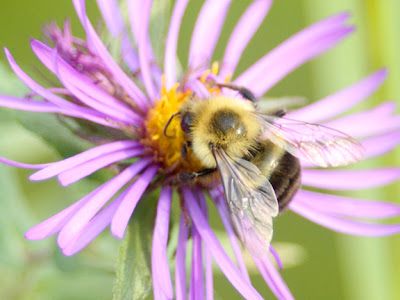Bees are an
essential component of the natural world. Through their foraging for nectar and pollen they, as well as butterflies and some other flying insects, pollinate many of the plants that the entire planet requires to survive.

Bees can also be deadly. When they sting they inject venom into
their victim. This venom typically produces a
localized allergic reaction which results in swelling, itching and pain. Some people however have a more serious
anaphylaxtic reaction which can result in shortness of breath, major swelling, nausea, vomiting, fever, falling blood
pressure and even possibly death.

My younger brother is hypersensitive to bee venom. When he was a kid he got stung and ended up having to go to the hospital. Unfortunately he is also
allergic to
Benedril, which is what they usually treat
allergic reactions with, they did not know this at the time so when they treated him he had a pretty serious reaction. Fortunately I do not share his condition and have never had a serious reaction to the many bee stings that I have
received during my life.

This bee is gathering nectar and pollen from an aster flower. It is most likely a purple-stemmed
aster. You can see some of the purple coloration on the flower bud. The pictures were taken near the Old Cedar Avenue Bridge, which is a part of the
Minnesota Valley NWA, back on September 26, 2008.

 Bees can also be deadly. When they sting they inject venom into their victim. This venom typically produces a localized allergic reaction which results in swelling, itching and pain. Some people however have a more serious anaphylaxtic reaction which can result in shortness of breath, major swelling, nausea, vomiting, fever, falling blood pressure and even possibly death.
Bees can also be deadly. When they sting they inject venom into their victim. This venom typically produces a localized allergic reaction which results in swelling, itching and pain. Some people however have a more serious anaphylaxtic reaction which can result in shortness of breath, major swelling, nausea, vomiting, fever, falling blood pressure and even possibly death. My younger brother is hypersensitive to bee venom. When he was a kid he got stung and ended up having to go to the hospital. Unfortunately he is also allergic to Benedril, which is what they usually treat allergic reactions with, they did not know this at the time so when they treated him he had a pretty serious reaction. Fortunately I do not share his condition and have never had a serious reaction to the many bee stings that I have received during my life.
My younger brother is hypersensitive to bee venom. When he was a kid he got stung and ended up having to go to the hospital. Unfortunately he is also allergic to Benedril, which is what they usually treat allergic reactions with, they did not know this at the time so when they treated him he had a pretty serious reaction. Fortunately I do not share his condition and have never had a serious reaction to the many bee stings that I have received during my life. This bee is gathering nectar and pollen from an aster flower. It is most likely a purple-stemmed aster. You can see some of the purple coloration on the flower bud. The pictures were taken near the Old Cedar Avenue Bridge, which is a part of the Minnesota Valley NWA, back on September 26, 2008.
This bee is gathering nectar and pollen from an aster flower. It is most likely a purple-stemmed aster. You can see some of the purple coloration on the flower bud. The pictures were taken near the Old Cedar Avenue Bridge, which is a part of the Minnesota Valley NWA, back on September 26, 2008.

Great shots! The last is a winner!
ReplyDeleteWell, bees lack feather but they also have wings!!! These are great macro shots. I love the details of the wings and the last shot is very beautiful.
ReplyDeleteGreat!!!!!Beautiful!!!!
ReplyDeleteGreats photos.
ReplyDeleteThanks for posting to TODAY'S FLOWERS.
Now, I know the name of this flower, Aster. Ive seen them a lot lately. Those are magnificent pictures of your bees.
ReplyDeleteYou do capture bees so well.
ReplyDeleteI have covered many posts about why we need to save the bees. I hope people are beginning to understand why. Stunning images.
ReplyDeleteMore great shots. Since I've been doing macros I'm not as afraid of bees as I used to be but this is a reminder that I should still be careful. I've never been stung and I don't want to change that.
ReplyDeleteNice Macro's !!
ReplyDeleteThat last flower is actually spotted knapweed. You can see that it lacks the yellow center like the flowers in the other photos, and the bract is shaped more like that of a thistle than a typical aster. Spotted knapweed is an invasive species and on the noxious weed list for many states, including Minnesota. It poisons the soil and prevents native plants from growing.
ReplyDelete